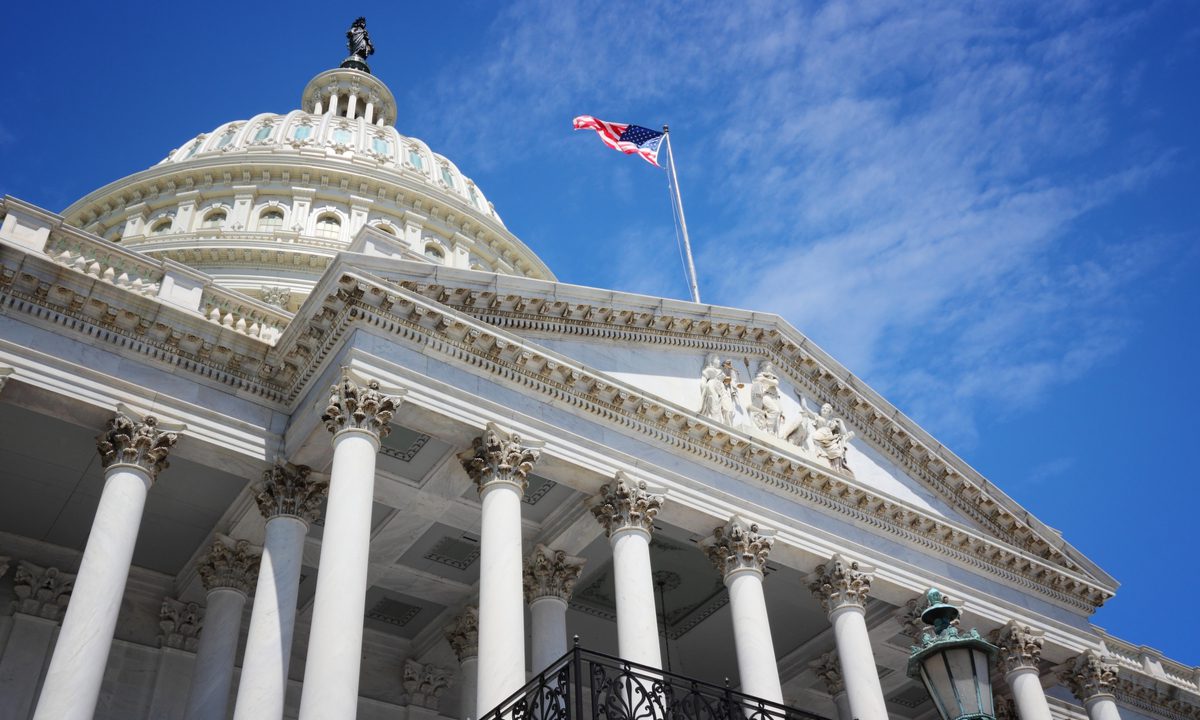Washington, D.C
Parents tote toddlers to D.C. to press for expanded child tax credit, child care funds • Michigan Advance

WASHINGTON — Families gathered outside the U.S. Capitol Tuesday to “make a fuss for babies,” who they believe are being left behind by lawmakers who direct only a fraction of U.S. resources to young children.
Parents and kids representing 50 states and the District of Columbia convened for the eighth annual “Strolling Thunder.” Moms and dads pushing strollers decked out in state license plates rallied on the Capitol’s East Lawn to lobby lawmakers to fund child care, establish national paid family leave, and permanently expand the child tax credit.
Matthew Melmed, executive director of ZERO TO THREE, the organization behind the event, rallied parents to tell their representatives that the 11 million babies in the U.S. “make up 3.4% of our population, but 100% of our future.”
“You’re here with the pork producers and the insurance lobby and the pharmaceutical industry. Members of Congress don’t normally see real people, and they rarely see babies and toddlers, particularly babies and toddlers who need to have their diapers changed on their desks. And that’s what I encourage you to do if you need to have that happen,” Melmed told the crowd.
The nonprofit ZERO TO THREE bases its advocacy on health and developmental research findings in infants up to age 3, the years the group describes as “the most important for lifelong mental health and well-being.”
Melmed praised top Democratic appropriators Sen. Patty Murray of Washington and Rep. Rosa DeLauro of Connecticut for achieving a $1 billion increase for child care block grants and Head Start in this year’s government funding bills.
DeLauro, who spoke to the crowd, said “families deserve better.”
“The cost of living has increased year after year, and more and more Americans simply do not get paid enough to live on, let alone to raise a family,” the Connecticut lawmaker said, promising to advocate for the reinstatement of a fully refundable child tax credit.
‘Diapers, child care, formula’
Candace Winkler, a former Alaska resident and current ZERO TO THREE leader, sat on the Capitol lawn next to Sabrina Donnellan who traveled to D.C. from Girdwood, Alaska, with her 13-month-old Blakely to advocate for lower child care costs and paid family leave.
Winkler, the organization’s chief development and strategy officer, said the group of families would divide up in the halls of Congress Tuesday to meet with their representatives about six key policy issues, including permanently expanding the child tax credit to pandemic levels.
“We’ve seen that time and time again that families are using those resources for diapers, child care, formula and things their babies and their family needs. And it’s really critical for their success,” WInkler said.
The current child tax credit is $2,000 a year after tax liability, but the amount a parent could receive per child under 17 in a refund check is capped at $1,600 in 2023. The credit phases in at 15% on every dollar after earnings of $2,500.
As the U.S. was digging out from under the COVID-19 economic crisis, Congress approved a one-year expansion of the tax credit to $3,000 per child under age 18, and $3,600 for those under age 6 — including for families who made $0 in income. Lawmakers made the entire amount refundable, and a portion of it was sent to families in monthly installments.
Advocates hailed the research findings that showed the temporary move was a game changer for lifting children from poverty in the U.S.
A current bipartisan proposal, widely supported by U.S. House lawmakers, to temporarily expand the child tax credit until 2025 — though not to pandemic levels — is currently stalled by U.S. Senate Republicans who liken aspects of the bill to a welfare program.
The proposal, as passed by the House, would increase the credit’s refundable portion to $1,800 in 2023, $1,900 in 2024 and $2,000 in 2025. The legislation would also increase the phase-in rate to 15% per child, simultaneously — in other words, 30% for a family with two children, 45% for a family with three, and so on.
Credit card debt for child care
Cruz Bueno, a parent from Rhode Island, shared her story of racking up credit card debt to enroll her 11-month-old Rosie in child care, along with her 2-year-old sister Amalia.
“Putting Rosie into daycare means that we must put a halt to our dream of buying a home,” said Bueno, an economist who lives in Warwick with her husband, Xhuljan Meta.
“One of the stipulations of our mortgage pre-approval was to keep our credit card balances low. Even so, we remain hopeful that one day in the not-so-distant future we will be able to buy a home to raise our girls and pass on wealth to them,” she said.
When asked about the Strolling Thunder event at Tuesday morning’s regularly scheduled House Republican press conference, House Speaker Mike Johnson of Louisiana said, “There’s lots of ideas out there. What we stand for, what our party stands for, is support of families. We support infants and children, and there’s an appropriate role to play in that.”
“The devil’s always in the details on legislation, so I’m not sure exactly what they’re proposing, but all of us are looking at those avenues. We want to support families. That’s good public policy,” Johnson said. “In our view, the best way often for the government to do that is to step back and allow the local and state officials to handle their business at that local level.”
Rep. Elise Stefanik, House Republican Conference Chair, said the GOP is “proud to be a pro-family conference.”
“There are many of our members who have proposed innovative solutions — one is rural child care. Home-based child care, that’s an issue I’ve worked with many of my colleagues on the Education and Workforce Committee,” Stefanik, of New York, said. “But the economy, the border, crime, these issues, these crises caused by Joe Biden, they impact every family.”

Washington, D.C
DC brings back popular ‘Late Night Hype' series to keep streets safe

Skip to content

Contact Us
Washington, D.C
D.C’s five-week countdown to summer starts with a dim Friday

The five weeks leading to summer started Friday, but in the District, Friday was also a day of overcast that concluded two weeks of clouds or rain.
Friday was the first day of the 35-day period that concludes on June 20, which this year is the day of the solstice, the start of astronomical summer.
Washington, D.C
Real ID: How to get yours in DC, Maryland & Virginia as deadline approaches

WASHINGTON – Americans have a little less than one year to get the Real ID they will need to board domestic flights or enter certain federal facilities.
All 50 U.S. states, the District of Columbia, and five U.S. territories are covered by the Real ID Act which was passed by Congress in 2005.
The new form of identification incorporates anti-counterfeiting technology and uses documentary evidence and record checks to ensure a person is who they claim to be.
The Department of Homeland Security pushed back the deadline several times during the COVID-19 outbreak. The current deadline is May 7, 2025.
An example of a Washington, D.C. REAL ID provided by the Department of Homeland Security (DHS)
How do I get a REAL ID in Washington, D.C., Maryland, and Virginia
At a minimum, you must provide documentation showing:
1) Full Legal Name
2) Date of Birth
3) Social Security Number
4) Two Proofs of Address of Principal Residence
5) Lawful Status.
Use these links to check D.C., Maryland, Virginia DMVs for any additional requirements:
DC Department of Motor Vehicles
Maryland Department of Transportation
Virginia Department of Motor Vehicles
What is REAL ID?
Passed by Congress in 2005, the REAL ID Act enacted the 9/11 Commission’s recommendation that the Federal Government “set standards for the issuance of sources of identification, such as driver’s licenses.” The Act established minimum security standards for state-issued driver’s licenses and identification cards and prohibits certain federal agencies from accepting for official purposes licenses and identification cards from states that do not meet these standards. These purposes are:
Accessing certain federal facilities
Boarding federally regulated commercial aircraft
Entering nuclear power plants
What happens when the REAL ID enforcement date begins?
Federal agencies, including DHS and TSA, may only accept state-issued driver’s licenses and identification cards as identification for purposes of accessing federal facilities – including TSA airport security checkpoints – if the license or card was issued by a REAL ID compliant state in accordance with the REAL ID security standards (meaning the license or card must include the REAL ID compliant star marking).
Real ID also will be required to enter some federal facilities such as military bases.
Here are some of the most frequently asked questions about making sure you are REAL ID ready.
-

 World1 week ago
World1 week agoPentagon chief confirms US pause on weapons shipment to Israel
-

 Politics1 week ago
Politics1 week agoRFK Jr said a worm ate part of his brain and died in his head
-

 Politics1 week ago
Politics1 week agoOhio AG defends letter warning 'woke' masked anti-Israel protesters they face prison time: 'We have a society'
-

 News1 week ago
News1 week agoNine Things We Learned From TikTok’s Lawsuit Against The US Government
-

 Politics1 week ago
Politics1 week agoBiden’s decision to pull Israel weapons shipment kept quiet until after Holocaust remembrance address: report
-

 Education1 week ago
Education1 week agoVideo: Police Use Pepper Spray on Protesters on G.W.U.’s Campus
-

 World1 week ago
World1 week agoA look at Chinese investment within Hungary
-

 News1 week ago
News1 week agoThe Major Supreme Court Cases of 2024







:quality(70)/cloudfront-eu-central-1.images.arcpublishing.com/dlnews/J3B5VUB4AJBETGDNWVTTBSEACE.jpg)











